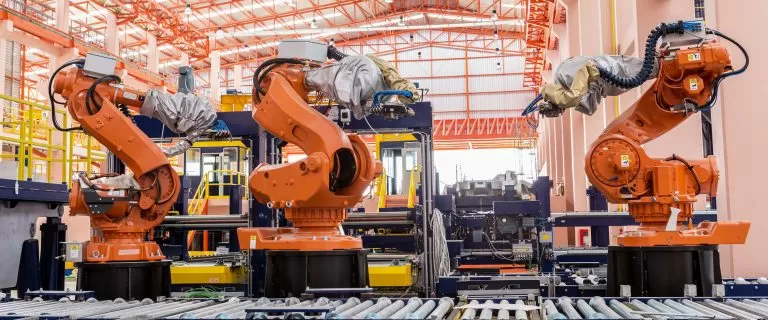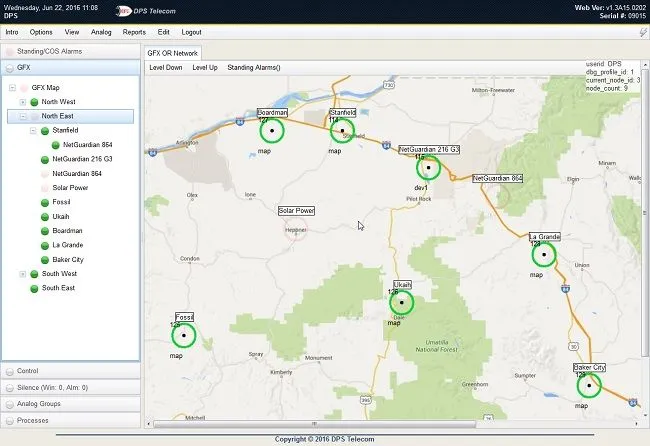Check out our White Paper Series!
A complete library of helpful advice and survival guides for every aspect of system monitoring and control.
1-800-693-0351
Have a specific question? Ask our team of expert engineers and get a specific answer!
Sign up for the next DPS Factory Training!

Whether you're new to our equipment or you've used it for years, DPS factory training is the best way to get more from your monitoring.
Reserve Your Seat TodayA Human-Machine Interface (HMI) is a combination of software and hardware that allows network technicians to operate their Supervisory Control and Data Acquisition (SCADA) system from a central location, unifying all device screens into one. With an HMI SCADA, you can monitor and control your complex manufacturing processes and visualize data from your facilities in real-time.
With new technologies, HMI solutions now offer more features than ever. They can have many essential capabilities, such as troubleshooting, data logging, remote accessing machines, and providing a communications interface between your multiple manufacturing machines.
So, choosing the right HMI is vital to maintain your manufacturing operations running efficiently. Being able to remote monitor and control your processes is critical to maintaining your manufacturing machines up and running at all times - enhancing your profitability.

But, we know that an HMI SCADA is a big investment and we have many clients reaching out to us as they need help to select a device that will give them the best ROI. Being in the remote monitoring solutions market for more than 30 years, it's safe to say that we know what makes an HMI device efficient. So, to help you as well, we've put together a list of important points that you need to take into consideration when choosing an HMI for your application.
If you are already searching for your HMI, you probably already noticed that not all SCADA systems are created equal. As the brain of your SCADA communication system, the HMI needs to be the right one for your specific requirements.
Let's take a look at some key factors when choosing an HMI SCADA.
Many facilities have legacy and new equipment from many different vendors. If that's your case too, then it's important that your HMI SCADA is a multiprotocol device that can effectively communicate with all your existing gear and unify all of them into one intuitive screen.
Many HMI devices can communicate only with modern protocols. This will be an issue if you have older equipment that only supports legacy protocols. In this case, you will be forced to buy additional hardware to translate the legacy protocol into one supported by your HMI, or you will have to replace all your legacy gear at once. Either way, you will be looking at expensive costs.
These additional costs can be avoided by ensuring that the HMI SCADA you select can work and communicate with any vendor's hardware, regardless of age.
HMI devices must be adaptable to changing requirements and new technologies. So, make sure you can download new firmware upgrades for free from your vendor's website and can upload these new features into your gear without any downtime is key.
Also, make sure that your HMI device supports backward compatibility. It becomes pretty expensive pretty fast if you need to replace your entire system to be able to talk to your newly upgraded HMI (not to mention this can cause downtime and data loss).
So, make sure you can not only get free firmware and software updates from your vendor but also backward compatibility so you don't have orphaned equipment into your SCADA system.
There have been many cases where SCADA systems were compromised by intruders with malicious intents. Due to the mission-critical nature of SCADA systems, with important data and the ability to remote control equipment, protecting it from unauthorized users and hackers is critical.
Make sure your HMI provides security to your system in many ways, from passwords, keeping track of login attempts, to adopting SNMPv3 encrypted messages.
Your vendor should be as committed to your system's protection as you are, providing cutting edge security technologies to safeguard your SCADA system.
Many vendors think scalability simply means purchasing more inputs/outputs (I/O). However, if you are going to add another production line or another plant in the future, then you will need a SCADA system that was designed to support that type of growth. Unlimited I/O is great, but there's no use if your system isn't built to handle it.
Talk to your vendor and make sure your HMI SCADA has been thoroughly tested to handle a large number of devices and I/O points before you make the investment. This way you can avoid slow response times and other problems associated with an HMI SCADA that was not designed to handle industrial use.
When you buy a manufacturing machine, you know that the initial costs are only a small percentage of the lifetime cost of that equipment. The same is true for your HMI SCADA.
Some SCADA vendors will tell you that since their HMI is lower-priced, it's a low-risk investment and you can simply discard it if you don't like it. Their HMI devices might even look like a bargain, but it's more efficient to simply make the investment in a device that really works and does the job the first time.
It's a waste of time and money to try your luck with devices that are throwaway. Selecting an HMI with multiprotocol capacity, intuitive web display, 24x7 detailed alarm notifications, are all elements present in a good investment.

Your HMI SCADA isn't a disposable device. If it goes down, the consequences to your organization can be serious, ranging from data loss that will impact regulatory compliance to unscheduled downtime that will affect customers.
For this reason, it's important that your SCADA vendor is there to support you when you need it. 24X7 technical support is key, as your system won't wait for regular business hours to present issues. Also, avoid companies that charge for technical support only to put you through an automated voice mail until you reach an untrained intern reading from a script.
Make sure your SCADA provider can also offer regular training taught by the same engineers that designed your HMI, as well as and tune-up visits to ensure you are getting the most out of your HMI SCADA device.
Your HMI SCADA is a big purchase. Not just in terms of initial costs, but in the ability to meet your needs today and years in the future. With such an important investment of your company's budget, you need to be certain your vendor will be in business for as long as you are.
Another consideration to keep in mind is your HMI vendor's experience in the remote monitoring and control industry. You don't just need someone to install a generic system, you need someone who thoroughly understands SCADA systems and can develop an HMI device that will attend your unique needs.
The reasons why you would want an efficient device might be obvious. But, have you stopped to think about all the not-so-obvious advantages that the perfect-fit solution can bring to you? Here are some that you can think about.
One of the main advantages of having an efficient HMI SCADA device is that your specialized personnel won't be caught up doing repetitive manufacturing tasks. This allows you to make sure they are performing more technical jobs.
Imagine that your production manager needs to conduct maintenance checks on all equipment one time per week or so. Monitoring the health and condition of your manufacturing machinery is critical, but an intelligent HMI can easily collect temperature, vibration, and performance data from RTUs and equipment located at your facility. With this data, your HMI can automatically provide you with trend analysis and point out any irregularities discovered.
Since your HMI SCADA can perform this task, your production manager will be able to give better attention to other duties.
In addition to that, an efficient HMI SCADA will help you save money with the costs of other devices over time.
The capabilities of a competent HMI will help you avoid having to add more features to your current and new equipment. You won't need to add indicator lights, for example, as all alarm alerts will be sent to you by via software and displayed on your HMI screen.
Also, the automated awareness into your manufacturing facility means that fewer potentially dangerous manual inspections will be needed.
Furthermore, an efficient HMI SCADA system will decentralize decision making. This means that more remote decisions will be able to be carried out.
Imagine that you or your production manager are away at another production facility. With an effective HMI, you can remotely access information from all your manufacturing sites, make decisions and send out commands to your machinery.
An efficient HMI SCADA will not only improve data processing and reporting, but it will also help decrease costs and enhance your ROI.
As technology evolves, more options and features become available, so deciding what's best for your scenario might become a challenge. There are many factors you need to keep in mind that will help you determine the best solution for your needs.
As a manufacturer, choosing the right HMI is essential. And as a manufacturing company ourselves, we know that we are always challenged to do more with less, while also meeting our clients' requirements. Having greater productivity and efficiency is the bottom line why manufacturing companies decide to deploy SCADA systems and ultimately HMI devices.
If you want an expert opinion about your unique scenario, give us a call. Our experts would be glad to discuss with you the best solution for your requirements.

Morgana Siggins
Morgana Siggins is a marketing writer, content creator, and documentation specialist at DPS Telecom. She has created over 200 blog articles and videos sharing her years of experience in the remote monitoring industry.